Brendan A. de Montigny and Christopher E. Payne
All recordings are binaural and/or mastered for headphone listening. All images by and courtesy the artists.
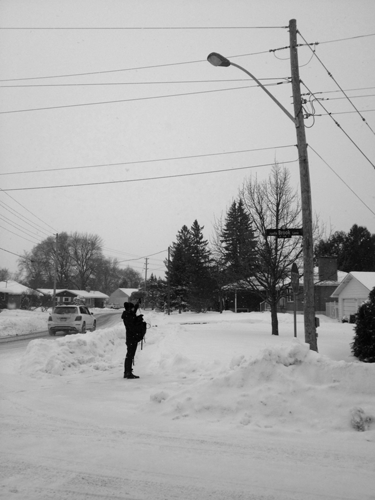
Recording, 2013.
October 2013 – January 2014
PROJECT METHODOLOGY:
I N T E R N A L METHOD:
(/MEMORY AS FACTS) +
[Sample group: Unknown Geographical Spaces re+visited]
(//MEMORY AS FICTIONS) +
[Sample group: known Geographical Spaces re+visited]
(///PROBABILITY OF DECAY-DEATH-RUIN)
[Resulting from Contemporary Urban Geography experienced]
= TEXT | (YOU THE PARTICIPANT) | AUDIO
NOTES: (OPTIONAL) Please continue to move superior rectus m., and inferior rectus m. to process the visual information stated in this project. You may also use (amongst others) the iris, pupil, cornea, anterior chamber, and ora serrate to aid in downloading any visual information.
E X T E R N A L METHOD:
[ORAL] (SOUND AS MEMORY\) +
[DIFFERENCE] (SOUND AS GEOGRAPHY\\) +
ART HISTORY (Echo Effect)
[Artist Emotional Output]
= A displacement, in which audio contrasts the potential preconception of the visual.
NOTES: (OPTIONAL) Please use headphones to stimulate some, if not all, of the parts (the malleus, incus, semicircular canal, cochlear nerves, and auditory tube)
‘That zero panorama seemed to contain ruins, that is- all the new construction that would eventually be built. This is the opposite of the “romantic ruin” because the buildings don’t fall into ruin after they are built but rather rise into ruin before they are built. This anti-romantic mise-en-scene suggests the discredited idea of time and many other “out of date” things. But the suburbs exist without a rational past and without the “big events” of history. Oh, maybe there are a few statues, a legend, and a couple of curios, but no past- just what passes for a future. A Utopia minus a bottom, a place where machines are idle, and sun turned to Glass…’[1]
B E G I N:
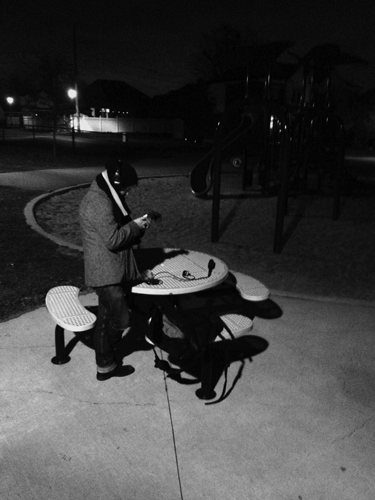
Oasis, 2013.
Saturday, 2 November 2013
18:20
45.387942° N -75.832593° W
Looking for a place we weren’t looking for.
BD: I am getting the impression we are just asking an endless series of questions that mimic that fact that we both have no idea where we’re walking to.
[We pause—it’s cold out for a fall day]
BD: It’s unnerving. I mean… we want to say something new, no?
CP: There are no new sounds, insofar as the ones you can relate to.
BD: Exactly, by the way where are we?
CP: Exactly, where are we?
BD: What?
CP: We are in the dissonance. This is our ‘echo location’ because it is like all other of the spaces we will record.
BD: Perfect. Let’s get started.
[Our first recording was in a municipal park that was themed to look like an oasis in a desert.]
[Disclaimer: both of the artists wish they could say that this was in any way intentional.]
What are the superimpositions of sounds in these ruins?
THE DECAY OF SUBLIMITY:
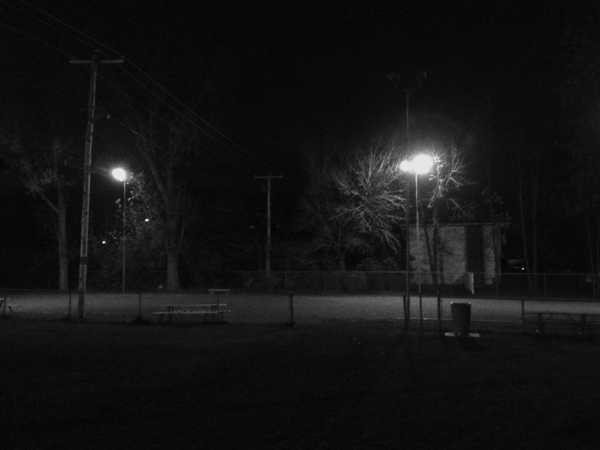
Walking, 2013.
Saturday, 2 November 2013
22:00
45.394894° N -75.802317° W
CP: Was this a park you grew up in?
BD: Yeah.
CP: Looks like a park I knew.
[It was late spring. The ritual went like this: my parents went to sleep by 9:45pm and by 10:00pm I crawled quietly out my bedroom window to take a stroll. I would walk over the well cut grass, then through a small hole in the chain link passage, and into the neighbourhood that had years of natural growth so the trees hung over the road casting shadows from the amber coloured streetlights. Once a few homes down, I’d search my oversized jean pockets, I’d press play on my Discman. Now moving through the crescents, the streets, and the boulevards, I knew that despite my state of mind I could, in any direction, walk towards the end of that neighbourhood and into the forest path within 10 minutes.]
[It is late fall now. I recount the ritual to CP, and I try to show him how I could escape the streets into the forest. Except now I could not find the path. At that old locale, there are a set of lights, a gas station, and a new neighbourhood spanning a new distance. We conclude that these homes are probably filled with teenagers also trying to sneak out of the windows to get high and find the idea of a landscape, or that unkempt forest. We conclude that this new space is not that much different than any other time before, aside from the fact we now have to walk a hell of a lot further to get out.]
EMERGENCE:
Monday, 16 December 2013
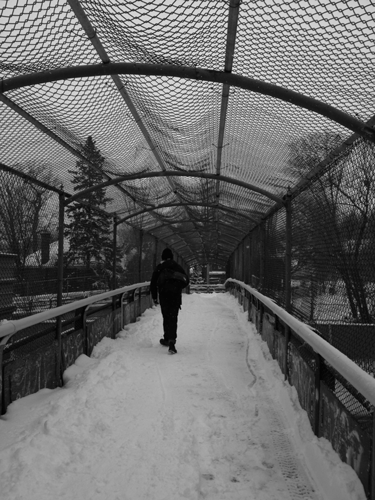
Emergence, 2013.
3:00 pm
Latitude: 45.393843° N -75.731056° W
[For a full day, our mutual friend drove us around Ottawa, ‘our nation’s capital.’ We got lost in a 2000 Honda Civic hatchback listening to the CBC. It was overcast and moderately snowing with a cold wind blowing from the north. The temperature hovered around -15 degrees Celsius. Our first stop was near Harmer street: we walked over a highway overpass that connected one neighbourhood to another that looked exactly the same. We stopped in the middle of the Queensway.]
CP: Yeah, this will do.
Mutual Friend: It’s really loud here…
BD: The sounds of our generation…
Mutual Friend: Fucking loud generation.
CP: Yup, it is.
Brendan: What do you think of the project?
Mutual Friend: It’s fucking loud.
BD: We are not only crossing highways, but a larger repeating vista that guide us into ruined, aging, suburban paths.
Mutual Friend: So it is like you are trying to capture a sense that the many roads of our daily lives that we take have a sound, and they are not being heard?
CP: Exactly… Now guys, please shut up and let’s record.
BD: I hear an ambulance in the distance. And we should capture that.
Mutual Friend: (laughing) Shhhh… It’s an emergency.
INTERMISSION
SOCIAL NOISE CANCELATION:
[It was fall. The ritual was this: before going to bed, and in the following order, I would choose my attire for the next day, and then put my latest punk record in the Discman so I could exit my suburban house and have something to listen to, to take my mind off of the long bus ride ahead. The third step to prepare for the day ahead took some finesse and went like this: I would prepare the coffee maker so that when I awoke I could press start and the brew would be ready by the time I would exit the shower. I would then place the liter of coffee in the freezer to cool down. Once dressed, I would take the now-lukewarm black coffee out of the freezer and place the contents in an oversized travel mug.]
[On one particular day I awoke late. To make matters worst I had miscalculated the shower-time to hot coffee ratio. So I ran to the bus stop chugging.]
[I approached the bus stop. I was going to make it, except I had difficulty seeing.]
[The sweat flowed over my brow and into my eyes. My belly ached from drinking too much so fast. My headphones were adjusted to the maximum level and pierced through my skull so loudly I could hear the punk screams in my retinas. My vision was doubling.]
[I remember seeing the next suburban neighborhood across the six-lane highway. All the similar homes seemed to be duplicating at an unnatural speed. I glanced down the road and I saw twice as many buses and cars. I tried to refocus, but I locked onto the spinning wheels of the vehicles enroute to the downtown core.]
[Transfixed, my gut reacted. I puked up all the coffee right as the bus rolled up to the stop.]
[I entered the bus, and peered up sheepishly apologizing. The unenthused driver took my ticket. I mustered as much decorum I could find in my now voided being. I claimed a seat and collected myself. I never took off my headphones and took solace in this fact because I did not have to acknowledge the social awkwardness. After a minute or two I turned the ear speakers down half way. Faintly, the sounds of the automobiles moving along, the hum of the bus, and the chatter of small conversation moved me along out of suburbia. As the route progressed through the boulevards and crescent shaped streets, I concluded that probably, no one took notice. I never ventured to listen anyway. I just escaped via headphones: a practical noise cancellation.]
THE GRAND PROJECTS HAVE COME TO AN END:
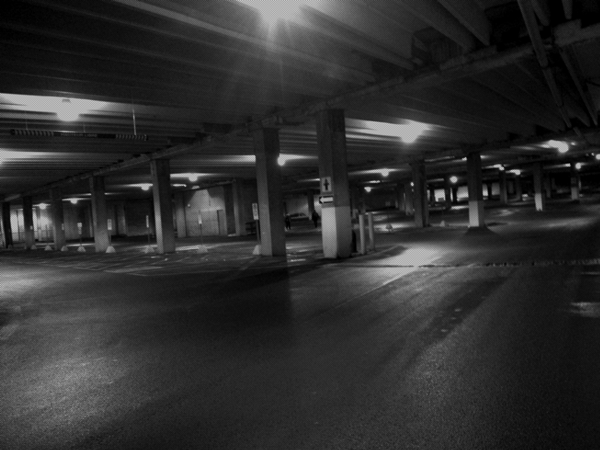
Grand Projects, 2013.
Wednesday, 15 January 2014
22:00
45.4721° N -75.7390° W
[The deadline approaches and we had ye not conversed about how we will finish this. Before beginning the journey along Boulevard Allumetieres, the subject of recording a final session first only came up briefly when I heard a knock on my door.]
CP: Are you ready? We got the equipment. You texted me twenty minutes ago saying you would have your snow pants, or long johns, or whatever, on. Let’s go.
BD: Sorry?
CP: It’s okay, but don’t bother… It’s only minus seven out, you really don’t need those snow pants.
[Later that evening, below Rue St-Joseph we walked, waiting once and awhile for a moment, a perfect sound to encapsulate our project. In the empty ‘in-between-ness’ of a sub floor parking lot of a shopping mall, looking out onto the highway, we found what we were looking for: we stopped at perpendicular, diagonal and parallel points so the sounds of the buses on St-Raymond might be heard, along with the cars rushing by. Amused onlookers waiting for their dealers looked on and attempted to determine why we were there. What was our agenda? We hardly knew ourselves. The parking lot had its own agenda; the security cameras must have recorded us moving back and forth. We noticed the sounds constantly shifting through the parking lot: passing buses and cars, and an architecture seemingly designed to minimize the human, an echo chamber for the automobiles.]
What sound is happening in that mid point between the road, common spaces and the private space, that lawn, that bungalow?
[To a certain extent, we proposed this project as a fantastical exploration of a future science fictional art history. We explored the curious moment of looking hearing awry: what happens when you listen instead of seeing? We would like to believe that there is some possibility for newness. Why should our language of perception, or this project, premise understanding primarily through seeing? Why that yard, corner, schoolyard, park, overpass, parking lot? There are way too many reasons, justifications, or possibilities, but on some level it always appears as though spaces call out for recording no matter what premise was used to find them. We set out to get ourselves lost, and twisted around, to find spaces like driftwood finds a beach, we washed up and recorded our destinations.]
[But what did we actually record? Was the documentation of our landscape, a travelogue and an attempt to find points of correlation or to provide evidence of some thesis? If that was our intent, and we doubt it ever was, we failed. Yet in the process there was something of a revelation, or another possibility present in thinking about the city through its sound. To a certain extent the sounds of this decidedly non-pastoral landscape are antiphonic. The small, individual and disparate sounds create a singular space. The space is proposed, and created, by the overlap of domestic and public sounds: the airplanes, cars, children, furnaces and our own bodies creating a sound—not just as individuals but collectively. The effect of this sound/space is not symphonic or anything like the excesses of a motet, but more like a four-piece band. There is a stripped down quality to it all. We could attempt to make the effect more dramatic, more pronounced, or known, but the complexity is inherent in its simplicity.]
[Really it is this idea of an antiphony, which seems to unconsciously have guided our actions from the beginning. We started with a title and methodology of ‘Call and Response’ where the two of us would comment, discover and write both as individuals and a collective; our technical resources mirrored this development, and the use of an ambisonic microphone allowed us to further explore the landscape, cataloging through its architecture—the minute and disparate sounds—creating a multi-dimensional recording.]
[1] Smithson, Robert. ‘A Tour of the Monuments of Passaic, New Jersey’, in Jack Flam (ed.) Robert Smithson: The Collected Writings (UCLA, Berkley: California, 1996), 72
Brendan A. de Montigny is a part time professor at Algonquin College in Visual Arts. He is also the co-owner and director at PDA PROJECTS in Ottawa ON. He has worked at galleries that represent active and exciting artist like Evergon, Michael Harrington, or Joe Fafard. Yet within his own research, de Montigny has positioned his artistic practice as being contrarian to Canadian commercial desires. His own art baulks and challenges the status-quo traditional aesthetics within a contemporary milieu. de Montigny holds an MFA from the University of Ottawa. On a full scholarship, he excelled in approaching and questioning themes of masculinity, utopia and our use of technology through drawing, painting and performance. de Montigny holds a BFA from Concordia University where he majored in painting and drawing, and a minored in print media. His MFA thesis exhibition was held at Ottawa’s City Hall Art Gallery. He has also participated in Toronto’s seminal arts conference NXNE. de Montigny has also exhibited his work at the AGO, The Strange Loops collective and at Living Walls Festival: Albany.
Christopher E. Payne holds a MFA of Visual Arts at the University of Ottawa, where he excelled in the research of new media, light art, and fine woodworking. He has held a number of administrative and technical positions with media arts centres and arts councils including time spent as a technical coordinator at both SAW Video and the Film and Video Arts Society of Alberta (FAVA). Payne studied film production at Concordia University’s Mel Hoppenheim School of Cinema during his undergraduate degree where he specialized in cinema-tography, editing, lighting and sound mixing. During his tenure at FAVA and SAW Payne learned digital cinematography and advanced digital editing techniques including colour correction and online mastering. He has also participated in a number of productions and performances across the country and internationally in Poland and Belgium and is involved with other media art domains such as stereoscopy, interactive film and video, live video performance, and expanded cinema.